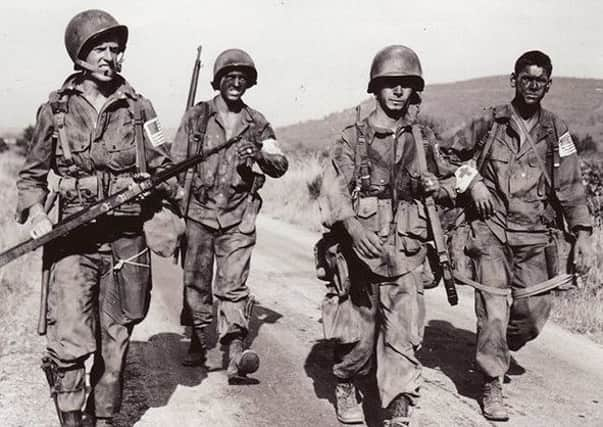Yanks for the memories: How US troops said goodbye to the Triangle


72 years ago, at 4am, on March 11, 1944, the area was a hive of activity as the American Paratroopers of the US 82nd Airborne’s 507th Parachute Infantry Regiment (Portrush) and 508th Parachute Infantry Regiment (Portstewart) were making ready for their departure to Belfast.
This was to be their first stop on their way back into the war and it set them on their way for their pivotal role in the biggest Allied invasion in history. A day that changed the world forever: D-Day, June 6th, 1944.
Advertisement
Hide AdAdvertisement
Hide AdOn December 9th 1943, the first men of the 82nd Airborne Division arrived in Northern Ireland. By the end of that day 12,000 of them had been disembarked from their ships in Belfast and were being transported to camps throughout the Province.
In total, the 82nd Airborne had approximately 15,000 men billeted in Cookstown, Aghadowey, Portglenone, Ballymena, Garvagh, Rasharkin, Kilrea, Bellaghy, Ballyscullion, Castledawson, Portrush and Portstewart.
Locally, the 508th Parachute Infantry Regiment (PIR) were accommodated in the purpose built Camp Cromore on the outskirts of Portstewart, and, the 507th PIR took up residence in the hotels, guest houses, empty buildings and B&B’s of Portrush. It was during their stay on the North Coast that the 507 and 508 were fully integrated into the 82nd to add significant numbers of men to the Division’s anticipated role in the future invasion of Europe.
Rumours that the 82nd were leaving Northern Ireland for England had been circulating from late January/early February 1944.
Advertisement
Hide AdAdvertisement
Hide AdA clear sign that the departure of the Division was imminent however came in late January when every trooper was told they could sew their beloved “AA” patches back on to their uniforms – an indicator that for now, the need for secrecy about their identity was coming to an end.
As February arrived and the wintry days passed by, Ulster townspeople became acutely aware that something was up with the troopers of the 82nd.
The young American men, who had arrived in Northern Ireland almost by accident, were starting to say their final goodbyes, swap addresses, settle bills, exchange keepsakes and give gifts to the locals who had overwhelmed them with their kindness, hospitality and friendship.
On the evening of February 13th 1944, 12,000 soldiers of the 82nd Airborne Division, minus the 507 and 508, made their final departure from these shores. In just one night, the once bustling camps took on a deathly silence.
Advertisement
Hide AdAdvertisement
Hide AdIn Portrush and Portstewart however, life went on for the 507 and 508. Many were realistic too about what they would still have to go through to achieve victory in Europe. Few could have forseen the true horror and sacrifice the Division would make on D-Day in the fields, villages, flooded marshland and skies over Normandy.
On March 9th, final word of departure came through and by March 11th 1944, the 507 and 508 were on their way. The logistical effort to move the 4060 troops of these two regiments from the North Coast was, like D-Day, impressive in it’s scale. Between 11pm and 6am, eight full trains left Portrush and Portstewart for Belfast.
D-Day took a terrible toll on the troopers who had been stationed in Portrush and Portstewart. As part of the “Boston Mission” on June 6th 1944, both the 507 and 508 as part of the 82nd Airborne Division, were dropped to the west of Ste. Mere Eglise.
Their mission was to establish a defensive line to the west of the Mederet River, take Ste. Mere Eglise and capture the La Fiere and Chef du Pont bridges – thus denying the Germans the ability to send reinforcements and armour to repel the landings at Utah Beach.
Advertisement
Hide AdAdvertisement
Hide AdOverall, the 82nd Airborne drop was widely dispersed with many regiments having their troops and resources scattered over a large area. Only one regiment, the 505 PIR under Lt. Col. Krause, succeeded in it’s designated mission of capturing Ste. Mere Eglise. This it did by 4.30am.
The 507 and 508 were dropped over a wide area to the west of the Mederet River and after 3 days heavy fighting, they finally secured the La Fiere bridge.
During Operation Neptune, the 507 PIR was decimated. Of the 2004 men stationed in Portrush, 303 had been killed in action, 254 had been wounded and 178 were missing. A similar fate befell their sister regiment, the 508, which had been billeted in Camp Cromore in Portstewart.
Of their 2056 troopers, 1,161 became casualties with 307 being killed in action on D-Day.
Advertisement
Hide AdAdvertisement
Hide AdThe stark reality is that of the 4060 men of the 507 and 508 PIRs of the 82nd Airborne Division stationed in Portrush and Portstewart from December 1943 until March 1944, approximately 610 men were killed on D-Day.
These were young men in their late teens and early twenties who enjoyed our coast, our scenery, our bars and cinemas, our cafes and chip shops, our friendship and hospitality in what we now know as the Triangle area.
After the war, the 507 dubbed Portrush as one of its “Homes from Home.
In 2005, Private First Class Howard Huebner, 507 PIR, summed up the regiment’s time in Portrush when he said,
“It will always be in our minds how nice the people treated us, and the good times we had while there.
“They will never be forgotten.”